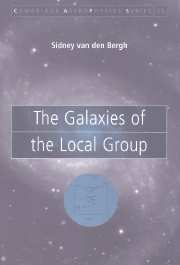Book contents
- Frontmatter
- Contents
- Preface
- 1 Introduction
- 2 Local Group membership
- 3 The Andromeda galaxy (M31)
- 4 The Milky Way system
- 5 The Triangulum galaxy (M33)
- 6 The Large Magellanic Cloud
- 7 The Small Magellanic Cloud
- 8 The elliptical galaxy M32 (= NGC 221)
- 9 The irregular dwarf galaxy NGC 6822
- 10 The starburst galaxy IC 10
- 11 Faint dwarf irregular galaxies
- 12 Spheroidal galaxies
- 13 The most luminous dwarf spheroidal galaxies
- 14 Dwarf spheroidals in the Andromeda subgroup
- 15 Faint dwarf spheroidals
- 16 The outer fringes of the Local Group
- 17 Intergalactic matter in the Local Group
- 18 Dynamical and physical evolution
- 19 Properties of the Local Group
- 20 Conclusions
- Glossary
- Bibliography
- Object Index
10 - The starburst galaxy IC 10
Published online by Cambridge University Press: 22 August 2009
- Frontmatter
- Contents
- Preface
- 1 Introduction
- 2 Local Group membership
- 3 The Andromeda galaxy (M31)
- 4 The Milky Way system
- 5 The Triangulum galaxy (M33)
- 6 The Large Magellanic Cloud
- 7 The Small Magellanic Cloud
- 8 The elliptical galaxy M32 (= NGC 221)
- 9 The irregular dwarf galaxy NGC 6822
- 10 The starburst galaxy IC 10
- 11 Faint dwarf irregular galaxies
- 12 Spheroidal galaxies
- 13 The most luminous dwarf spheroidal galaxies
- 14 Dwarf spheroidals in the Andromeda subgroup
- 15 Faint dwarf spheroidals
- 16 The outer fringes of the Local Group
- 17 Intergalactic matter in the Local Group
- 18 Dynamical and physical evolution
- 19 Properties of the Local Group
- 20 Conclusions
- Glossary
- Bibliography
- Object Index
Summary
Introduction
Mayall (1935) was the first person to draw attention to this highly obscured galaxy, which is located at b = –3°.3. He pointed out that “the original negatives show, almost conclusively, that IC 10 is an extra-galactic object.” Hubble (1936, p. 147), who called it “one of the most curious objects in the sky,” first raised the possibility that IC 10 might be a member of the Local Group. This suspicion was subsequently confirmed by the Cepheid distances of Saha et al. (1996) and Wilson et al. (1996). Photographs in blue and red light of this galaxy have been published by Roberts (1962) and by de Vaucouleurs & Ables (1965). From an inspection of these images the DDO classification of this object appears to be Ir V:, the luminosity class is uncertain because of the large Galactic foreground obscuration. Roberts (1962) notes that the optical and 21-cm radio centers of IC 10 agree within their errors.
Distance and reddening
The integrated colors of IC 10 have been measured by de Vaucouleurs & Ables (1965). From these colors they estimated the reddening of this galaxy to be 〈E(B – V)〉 = 0.87. Using the colors of four Cepheids, Wilson et al. (1996) find a range in reddening of 0.6 ≲ E(B – V) ≲ 1.1 mag. From their data they adopt a mean value E(B – V) ≈ 0.80. Using this value, Wilson et al. obtain a true distance modulus of 24.57 ± 0.32, corresponding to a distance of 820 ± 80 kpc.
- Type
- Chapter
- Information
- The Galaxies of the Local Group , pp. 177 - 181Publisher: Cambridge University PressPrint publication year: 2000
- 4
- Cited by

